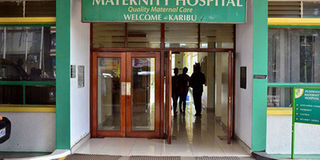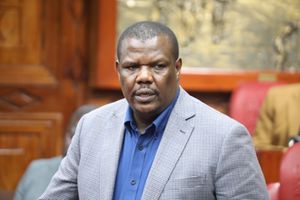Breaking News: Schools to reopen on Monday, Ruto announces
Before Margaret Kenyatta there was Lady Grigg

Pumwani Maternity. It is a landmark institution left behind by Lady Joan Grigg. PHOTO | FILE | NATION MEDIA GROUP
What you need to know:
- Before Lady Grigg began her campaign in Kenya, Uganda had also trained dozens of African women to become government-certified midwives.
- It was Lady Grigg who started advocating the training of local midwives and nurses in the hope that many babies and lives would be saved during childbirth
Every time I watch First Lady Margaret Kenyatta prepare for the annual Beyond Zero marathon, my mind is thrown back to the long walk that this country has done to address maternal healthcare.
It is a scandal that 90 years after a similar campaign was started in this country, we are still having mothers die while giving birth.
Mrs Kenyatta’s only equivalent — if she succeeds — will be colonial-era Lady Joan Grigg who left a mark at Government House (today’s State House) by going around the country and mobilising resources through her Lady Grigg Child Welfare League to build maternities at a time when Kenya was Africa’s laughing stock — thanks to its inept (or lack of) network of maternities.
Lady Grigg was the wife of colonial Governor Sir Edward Grigg, and the landmark institutions that she left behind are all there to see: Pumwani Maternity in Nairobi, Lady Grigg Maternity, which is now part of Coast General Hospital, Lady Grigg Indian Maternity Home in Ngara — which later housed Fig Tree Hotel — and various other nursing homes that mimicked her success.
PERCEPTION
Her pamphlets — and I have seen some at the National Archives — were always catchy, though patronising.
While she drew everyone’s attention to the importance of mothers as the conveyors of good health practices, her criticism of local mothers “for carrying babies strapped on their backs or placing them on the ground while they worked in the fields” was a bit condescending. (Which childid wasn’t placed on the ground in the 1920s as our mothers tended the crops?)
The only problem is that few people know Lady Grigg, and those who do think of her negatively.
Those who have read Paul Spicer’s The Temptress: The Scandalous Life of Alice de Janze and the Mysterious Death of Lord Erroll, Countess de Janzé would only remember Lady Grigg for influencing her husband, Governor Grigg, to declare Alice de Janze — one of the most beautiful socialites in Kenya — persona non grata.
Alice was one of the Happy Valley sets and was being described by conservative settlers’ wives as “mad, bad, and dangerous to know” — especially in Wanjohi Valley in Nyandarua.
HEALTHCARE
In those days, white single European women were not allowed into Kenya; and to be admitted one had to first head to Mombasa Cathedral to be married before embarking on the train journey to Nairobi.
Alice had just divorced and gone to Europe to give birth since there were no credible maternities here.
She had also befriended Lord Delamere, whom she couldn’t marry since Delamere was courting Lady Markham — a story for another day.
Paul Spicer describes Lady Grigg as the “colony’s self-appointed moral guardian” — but besides that, her passion to build maternities for both African and Asian women was unparalleled — or as she once put it, her desire was to provide a clean labour ward for “the untutored mothers of the race who live lives of drudgery under tribal conditions”.
Nobody can take that legacy from her.
Lady Grigg’s fundraising was actually one of the first maternal and child healthcare programmes in Kenya as she mobilised efforts to encourage hospital births, arguing that the poor housing conditions in rural Kenya were contributing to maternal deaths.
MIDWIVES
Kenya was a latecomer into maternal healthcare campaigns, and in the 1920s its medical department was criticised for failing to take an interest in maternal healthcare compared to both Tanganyika and Uganda.
In Uganda, two Church of Scotland missionaries, Drs Albert and Catherine Cook, had in 1918 started training midwives at the Lady Croyndon Maternity Training School and by 1929, Tanganyika (now Tanzania) had recorded 342,221 attendances at its maternity and child welfare clinics compared to Uganda’s 105,099 ante-natal outpatients.
Kenya had an embarrassing 18,110 and did not have a single trained African midwife in 1929. Tanzania had eight.
Before Lady Grigg began her campaign in Kenya, Uganda had also trained dozens of African women to become government-certified midwives.
More than 90 years later, we are still running around looking for money to build maternal healthcare infrastructure.
PUMWANI
It was Lady Grigg who started advocating the training of local midwives and nurses in the hope that many babies and lives would be saved during childbirth — and it is a pity, nay a scandal, that more than 90 years later, First Lady Margaret Kenyatta is still struggling to put maternal healthcare as part of our national conversation — “No woman should die while giving birth”.
When Pumwani opened doors on August 1, 1927, it was hoped that many other maternity wings would be opened in the countryside.
The only problem was that Lady Grigg would not stay for long in Kenya since her husband’s tenure lasted for only six years.
But her fundraising efforts at Theatre Royal (as Cameo Cinema was then known) were epic.
Even after she left, her charitable outfit, which continued to operate, picked her vision and started the training of midwives in the country — a story that most of the pioneer African nurses love to tell.
TRAINING
But the credit for the Pumwani fundraising also went to the Chief Native Commissioner and Chair of the Native Maternity Home Committee G.V. Maxwell, also nicknamed “Fiji Wewe”, who organised a series of fundraisers for maternities at a time that three leading women, including Lady Northey and Olga Witkins, were competing on who would initiate the best project for either women or children in Nairobi.
Maxwell, in one of his letters dated September 24, 1928, described the purpose of the facility as to “train girls who, it is hoped, will afterwards be useful in the reserves … it appears to me that the purpose of the institution is too much for the benefits of the native population”.
Funds to construct Pumwani Maternity were sourced from a ball held at Government House, now State House Nairobi.
They were collected from the government, private donations and the 20 Local Native Councils around the colony.
The small native councils gave annual assistance of £37.10 while bigger ones gave £50 sums.
ACHIEVEMENT
Archival records show that Pumwani became a popular destination with its daily fee of 50cts for treatment and accommodation.
The annual fees from patients amounted to £60 against an annual maintenance budget of £1,500 by 1928 — and as such, it required much more donations to keep it running.
It would also start training local midwives with Maxwell asking councils to send trainee nurses and midwives to learn the “elementary principles of hygienic measures” and later graduate with a “Government Certificate for African Nurses” — under the guidance of Miss L.E. Begbie, the first Matron at Pumwani.
The Second General Report from the Lady Grigg Welfare League on the Pumwani maternity captured the picture of a landscape that did not care about mothers.
“Expectant mothers died of ruptured uteruses; obstructed births due to female circumcision were common while others arrived after nine days of labour and the child to be had already decomposed.”
As Elspeth Huxley would later write in her book, Out in the Midday Sun, Joan Grigg’s “was a remarkable achievement”. What went wrong?
CHAMPION
Maternal healthcare did not expand beyond the efforts of Lady Grigg — and efforts had been done by President Moi to start Nyayo maternity wards in every district hospital.
Also, various rural dispensaries started building maternity wards, which were ill-equipped to handle emergencies.
Again, there was no policy guidance on the maternity wards, and as such the Auditor-General was always complaining about the misuse of funds.
Beyond Zero campaign is our chance to look at the dreams of Lady Grigg, evaluate the Nyayo wards, and think on what kind of maternal healthcare our women and children deserve.
First Lady Margaret Kenyatta can perhaps guide the country through what Lady Grigg did some 90 years earlier — from the lawns of State House. After all, that is what First Ladies are remembered for.
[email protected]; @johnkamau1




